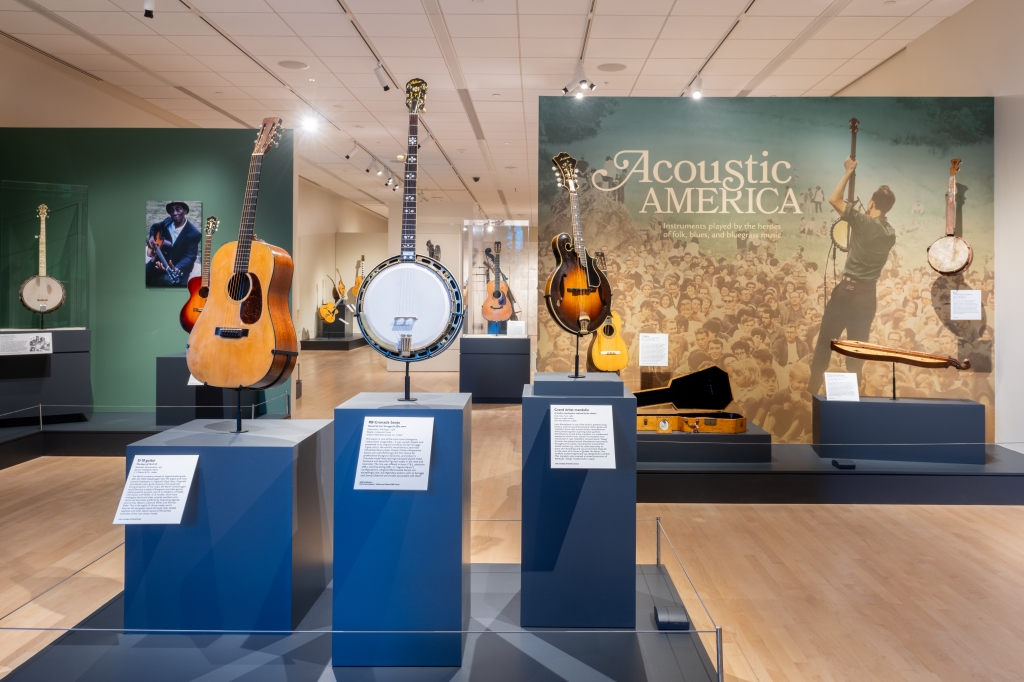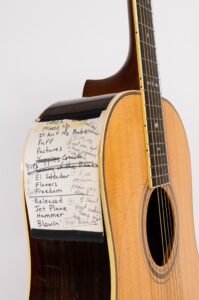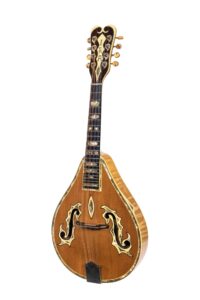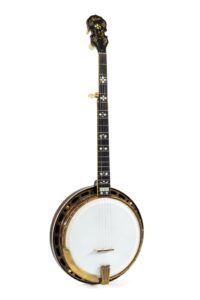String Fling

Writer Joseph J. Airdo // Photography Courtesy of the Musical Instrument Museum



The Musical Instrument Museum in Phoenix has hosted a number of captivating special exhibitions over the past decade, including “The Electric Guitar: Inventing an American Icon,” “Congo Masks and Music” and the recent “Treasures: Legendary Musical Instruments.”
While brainstorming different ideas for its next special exhibition, staff began contemplating the collections of the generous individuals whose loans make up many of the more than 4,200 instruments on display at the museum from every corner of the globe.
“We are lucky to work with a variety of people out in the world who have some pretty remarkable collections,” says MIM senior curator Rich Walter, noting that David Grisman is among the most generous and cooperative. “In addition to being a really phenomenal and influential mandolinist and composer, David Grisman has an extraordinary personal collection of instruments.”
One such instrument is a 1980 Grand Artist model mandolin that Grisman played on numerous albums and with other superstars such as Stéphane Grappelli and Chet Atkins.
“It was made by a luthier named John Monteleone, who lives in New York, is still working today and is considered one of the greatest builders of all time,” Walter says of the iconic instrument notable for its elegant carved scroll, points and proportions. “It is like having a Picasso.”
Walter adds that the 1980 Grand Artist model mandolin is just the tip of the iceberg when it comes to Grisman’s collection.
“He has got not only some amazing mandolins from his own career but also things that were played by really influential mandolinists through time; people from the Vaudeville era, people from the late 19th century, virtuosic Italian mandolinists who emigrated to the United States,” Walter explains.
Grisman’s collection became the catalyst for MIM’s latest special exhibition — “Acoustic America: Iconic Guitars, Mandolins and Banjos,” which showcases more than 90 historic acoustic stringed instruments played by the heroes of folk, blues and bluegrass music.
“We then reached out to a number of other collectors and performing artists and realized that we had a real critical mass and could build on that foundation,” says Walter, noting that the special exhibition features 90 instruments from about 30 different sources — including 30 from Grisman’s personal collection and many from MIM’s permanent collection.
“These instruments have been a real universal companion to our lives going back before the Civil War. They are the foundation of a lot of different genres of music. Every single one is a distinctive object, makes a distinctive sound and has been used in really distinctive careers. Each one has a unique story and personality, but together they remind us of the shared connections within America’s most influential music.”



Acoustic Artistry
Immediately upon entering the gallery, guests are greeted by a guitar, a mandolin and a banjo — each of which is an excellent example of its kind, with the guitar being the eighth Martin D-18 ever made back in 1933.
“The banjo is one of Earl Scruggs’ personal instruments,” says Walter, noting that the 1928 RB-Granada is a gold-plated Mastertone that the world’s most famous and influential banjo player has owned, played and preserved in original condition for more than 50 years.
Once their captivation by the first three instruments starts to subside, guests will discover that the gallery is filled with other astounding examples of acoustic artistry everywhere they turn — such as a one-of-a-kind mandolin customized by Ira Louvin in the flashy style of professional country music artists.
The special exhibition also features a 1935 Martin “Herringbone” D-28 guitar that made a significant impact on American music when folk icon Elizabeth Cotten used it to record her famous song “Freight Train” and others for Smithsonian Folkways in 1957 and a vintage A. A. Farland open-back banjo played by John Hartford, whose classic “Gentle on My Mind” became one of the most recorded songs in history.
Also on display is a Dobro guitar that LeRoy McNees — aka LeRoy Mack — played on an episode of “The Andy Griffith Show” in 1961 as a member of influential bluegrass group the Kentucky Colonels, under the alias the Country Boys, as well as famed Gibson acoustic engineer Lloyd Loar’s personal 1924 F-5 mandolin.
“Acoustic America” also includes a 1964 Guild F-30 guitar that blues legend Mississippi John Hurt hand-picked to play at the 1964 Newport Folk Festival. The instrument is on loan from John Oates who, having idolized and closely studied Hurt’s music, borrowed the guitar to record the first two Hall and Oates albums in 1972 and 1973.
Many items in the gallery represent a historical significance that extends far beyond the arts, such as a 12-fret dreadnought acoustic guitar that tireless ambassador for civil rights and social justice Peter Yarrow played when Peter, Paul and Mary joined Bob Dylan and Stevie Wonder to sing “Blowin’ in the Wind” at the inaugural celebration of Martin Luther King Jr. Day as a national holiday in 1986.
“I think that the oldest instrument [in the gallery] is an 1849 fiddle on loan from Jenee Fleenor, who is coming up on her fifth consecutive Country Music Association Musician of the Year award,” Walter says. “We also have a Martin guitar that dates back to about 1860 and literally witnessed the end of the Civil War in Richmond, Virginia.”
The special exhibition also features a few examples of how acoustic instruments are still being innovated today.
“We have a prototype of a brand-new guitar design that was unveiled to the public just about two months ago,” explains Walter, with the aptly named Versitar sounding warm, articulate and full, whether strummed, flat-picked, thumb-picked or played finger-style. “It was designed by George Gruhn, a world-famous historian, dealer and collector in Nashville. It is neat to see how these experts are still reimagining the possibilities with these instruments.”



Musical Melting Pot
MIM’s latest exhibition tells a story of American music through instruments that have over time been manufactured here in the United States by a variety of builders and played by a variety of artists.
“Just like the story of the United States, the backgrounds of so many of these people begin in other countries,” Walter says. “They are from Sweden, Germany, West Africa, Portugal, Mexico, Italy; these influences come from all over the world. It is similar to the whole melting pot idea of the United States.
“Another part of the story is the fact that some of these genres with signature sounds of American music, like blues and bluegrass, have gone back out into the world and become internationally recognized.”
Noting that MIM is honored and proud to present such a great cross-section of outstanding objects through “Acoustic America,” Walter believes that the special exhibition will really punctuate the museum’s ability to represent human beings through musical instruments.
“This is, after all, what I think MIM does best,” the curator adds. “Each of the musical instruments in this special exhibition is visually interesting, beautifully built and a part of history. That is exactly what MIM loves having on display for people to discover.”
‘Acoustic America: Iconic Guitars, Mandolins and Banjos’
Through Sept. 30 // 9 a.m.–5 p.m. // Musical Instrument Museum // 4725 E. Mayo Blvd., Phoenix // $10; discounts available // 480-478-6000 // mim.org

